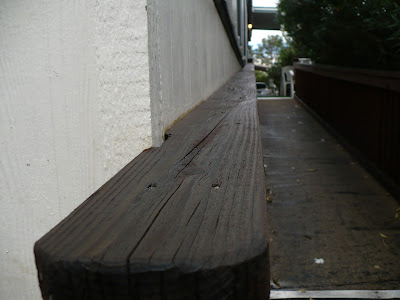 |
| Rainwater beads up nicely on this freshly stained wood. |
Nothing beats a trial by fire. Or, in this case, rain. We thought we did a good job of staining this wooden wheelchair ramp, but a nice little rainstorm early this morning really put it to the test. The water beaded up and ran off just like it should.
 |
| Even these handrails repelled water well. |
We inspected the whole job and found that even the dryest and most weathered wood took the stain well and is repelling water as it now should. It doesn't rain often in the desert, but when it does, it still does damage to wooden structures so this was worth doing.
 |
| Why stain your wooden hardscape? This picture tells the tale. |
We had some stain left over after finishing the ramp (better too much material than not enough), so we stained a few other wooden hardscape objects as well. It makes them all match and they all needed protection just as badly as the ramp did. The puddles on this raised garden bed tell the tale of why staining wood outdoors is worthwhile.
But how does water repellant wood stain work? I mean, it's liquid itself right? It soaks into the wood, especially this weathered wood, really well. It didn't form a plastic like coating on the surface of the wood. Other than being a little darker, it looks and feels the same as before. But now the rain water isn't soaking in. I did some research.
The first thing I found out was that the stain we chose contains linseed oil. The oil fills the pores in the wood so that water cannot enter them. It, like all oils, is naturally water repellant. Everything is made from atoms which are incredibly tiny, electrically charged particles made up of negative electrons, positive protons and neutral neutrons and those atoms are combined to form molecules. Some molecules are fundamentally stable enough to be considered elements, such as the oxygen and hydrogen that make up water. The hydrogen bonds that hold water molecules together are such that they leave some electrons still free to attract to other positively charged molecules, such as those that make up cotton fibers (which is why cotton clothes soak up water like a sponge).
Oil on the other hand, is made of chains of molecules that are bound together in ways that there aren't nearly as many electrons free to bond with other things, making a liquid oil nearly neutral in charge, thus the negatively charged water isn't attracted to it. It get's quite complex, but that's about the most simple way to explain it.
 |
| A great picture of the flax plant and its products by Handwerker on Wikimedia Commons.com |
 | |
| Water molecules. Note the positive charge of the hydrogen (H) is attracted to the negative charge of the oxygen (O) |
The stain we used also has what they call WaterGuard water repellants, which are trademarked and not disclosed, but are likely to be man-made polymers that are a lot like natural oils and that enhance the properties of the linseed oil.
In addition to the raised bed, we also stained this wooden fence protecting a little patio area.
 |
| Water is running off this wooden fence now. |
 | |
| Stained this shade awning for the water system |
And this shade awning. Shade awnings like this are essential for protecting hoses, pipes, etc. of water systems for homes in the desert. Otherwise, the UV light from the sun will weaken the rubber and plastic they are made from. The awning also reduces the amount that the water gets heated during the summer so that water won't be so warm when it comes from the tap in the sinks.
Staining wood isn't terribly fun as it's difficult to keep the stain from getting on places where you don't want it and it's a sticky mess to get off your hands (rubbing alcohol on an old rag works about as well as anything), but it is important for having a sustainable landscape. Being sustainable and environmentally friendly includes preventing materials in the landscape from becomming so damaged that they have to be thrown away and replaced. By protecting these wooden structures, we're avoiding adding damaged wood to the landfill (or even the effort, time and money involved in getting it recycled before its useful life is truly over) and avoiding having to contribute to the demand for new lumber (and all the enviromental costs involved there), at least for the time being.











































